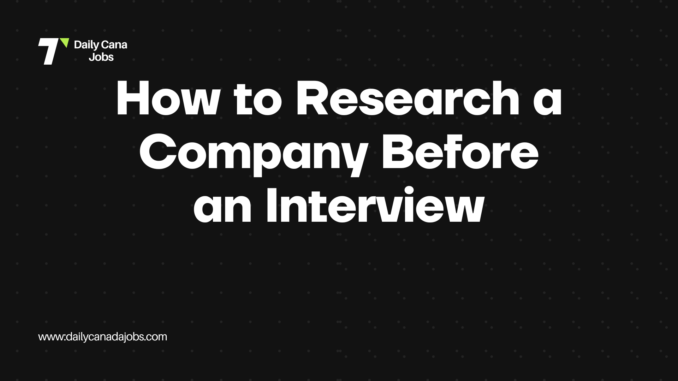
Thorough company research is the most underutilized interview advantage. While 91% of hiring managers say they expect candidates to research their company before interviews, only 49% of candidates do meaningful preparation. This 15-minute research method will position you in the top tier of candidates by providing insights that make your answers more relevant and demonstrate genuine interest in the organization.
The 15-Minute Research Framework
This efficient framework focuses on the most impactful information rather than trying to memorize every company detail. Set a timer for each section to maintain focus and efficiency.
Minutes 1-3: Company Basics (Foundation)
Where to look: Company website (About Us, History, Leadership pages)
What to capture:
- Founding year and original mission
- Current size (employees, locations, market position)
- Core products/services and primary customer segments
- Mission statement and core values
- CEO name and background
Why it matters: These fundamentals provide context for all your other research and help you speak knowledgeably about the company’s foundation.
Example insight: “I noticed that although you’ve grown to over 500 employees, your mission statement still emphasizes the customer-first approach from when you were founded in 2008. How has maintaining that focus influenced your team culture as you’ve scaled?”
Minutes 4-7: Recent News (Current Priorities)
Where to look: Company newsroom/press page, Google News search, LinkedIn company page
What to capture:
- Major announcements from the past 3-6 months
- New products or services launched
- Leadership changes or restructuring
- Acquisitions or partnerships
- Awards or recognition
Why it matters: Recent news reveals current priorities and challenges, allowing you to align your experience with their immediate needs.
Example insight: “I read about your recent partnership with TechCorp to enhance your data analytics capabilities. My experience implementing similar analytics tools at my current company could be valuable as you expand in this area.”
Minutes 8-10: Financial Health (Business Context)
Where to look: For public companies: Latest earnings report summary, Yahoo Finance
For private companies: Crunchbase, funding announcements, LinkedIn employee growth
What to capture:
- Revenue trends (growing, stable, declining)
- Recent funding rounds or major investments
- Profitability status (if available)
- Key financial challenges or opportunities mentioned
Why it matters: Understanding financial context helps you gauge stability and growth trajectory, informing how you position your value.
Example insight: “I noticed from your recent Series C funding announcement that you’re planning to expand into European markets. My experience localizing products for German and French markets could be particularly relevant to that initiative.”
Minutes 11-13: Culture and Work Environment (Team Fit)
Where to look: Glassdoor reviews, LinkedIn employee posts, company social media, careers page
What to capture:
- Recurring themes in employee reviews
- Work style (collaborative vs. independent)
- Communication norms (formal vs. casual)
- Remote/hybrid/in-office expectations
- Notable perks or benefits emphasized
Why it matters: Cultural insights help you demonstrate fit and adapt your communication style appropriately.
Example insight: “Your careers page emphasizes cross-functional collaboration, which aligns perfectly with my experience leading projects across engineering, design, and marketing teams.”
Minutes 14-15: Competitors and Industry Position (Strategic Awareness)
Where to look: Industry news sites, company’s own competitive comparisons, Google search for “[Company] competitors”
What to capture:
- 2-3 main competitors
- Key differentiators for this company
- Industry trends affecting the business
- Market challenges the company faces
Why it matters: Understanding competitive positioning shows strategic thinking and broader business awareness.
Example insight: “I’ve noticed that while your competitors are focusing primarily on enterprise clients, your recent product launches seem targeted at mid-market companies. Is that emerging segment a strategic priority for the team I’d be joining?”
Organizing Your Research for Quick Reference
Create a one-page “company brief” with bullet points under each category. This serves as a quick reference before your interview and demonstrates your organizational skills if you bring it with you.
Strategic Application During the Interview
Weave Research Into Your Answers
Rather than dumping research facts, integrate insights naturally into your responses:
Instead of: “I read that you recently acquired TechCorp.”
Try: “My experience leading integration teams would be valuable given your recent acquisition of TechCorp, especially in maintaining consistent customer experience during transitions.”
Ask Informed Questions
Use research as a foundation for thoughtful questions:
Instead of: “What’s your company culture like?”
Try: “I noticed your CEO’s recent blog post emphasized building a culture of innovation. How does that manifest in day-to-day work within this particular team?”
Address Company Challenges
Show you understand their pain points:
Instead of: “What challenges does the company face?”
Try: “Your recent expansion into the healthcare vertical seems exciting but potentially complex given the regulatory environment. How is the team approaching those compliance challenges?”
Research Red Flags to Avoid
Surface-Level Information Only
Don’t rely solely on the homepage or Wikipedia. Dig deeper for meaningful insights.
Outdated Information
Ensure your research reflects current reality, not historical facts from years ago.
Competitor Confusion
Don’t mix up the company with competitors or mention initiatives from the wrong organization.
Excessive Focus on Negatives
While being aware of challenges is important, don’t dwell exclusively on problems or controversies.
By implementing this efficient research method, you demonstrate not only your interest in the role but also your analytical abilities, strategic thinking, and preparation ethic—qualities that distinguish exceptional candidates from the merely qualified. This targeted approach ensures you make the most of limited preparation time while maximizing your interview impact.
Leave a Reply